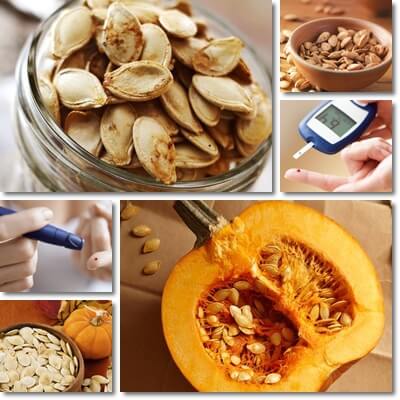Eating pumpkin seeds separate from other foods doesn’t actually lower blood sugar, but doesn’t raise it too much or too fast either. At the same time, eating them with other foods may lower the glycemic effect of those other foods and consequently also blood sugar levels post-meal. If you have diabetes, it’s actually recommended to throw in some pumpkin seeds or other types of seeds if you’re eating foods with a higher glycemic index or a higher carbohydrate content than the seeds to reduce their glycemic effects and impact on glucose metabolism.
Do pumpkin seeds raise blood sugar?
Barely. Pumpkin seeds are a source of carbohydrates, albeit a modest one, and technically fuel blood sugar rises. During digestion, carbohydrates are broken down into sugar, their simplest form, which is then absorbed into the bloodstream where all nutrients from food are taken up. Naturally, this causes blood sugar levels to rise. But what’s important is that the rise in blood sugar produced by eating pumpkin seeds is not significant at all, nor too quick so there won’t be any major fluctuations in blood sugar levels. Overall, the effects of eating moderate amounts of pumpkin seeds with diabetes are minimal, close to imperceptible.

On average, 100 g of pumpkin kernels has 13-15 g of total carbohydrates of which only 6.5 to 8.5 g are digestible carbohydrates and 6.5 g indigestible carbohydrates in the form of dietary fiber. What this means is that only these 6.5-8.5 g of carbs get broken down into sugar during digestion (which is very little). The remaining 6.5 g of indigestible carbohydrates – the dietary fiber – doesn’t actually get digested and doesn’t contribute to our nutrition. Not for lack of trying though, since the gastrointestinal system still tries to process the fiber somehow. Instead, fiber only slows down the digestion process contributing to minimal effects of the kernels on blood sugar levels.
Other elements of nutrition in the seeds further accentuate the low glycemic effects, notably fat and protein. 100 g of the kernels provides an average of 43-49 g of fat and between 23-30 g of protein, which is a lot. The generous amounts of both protein and fat further lengthen digestion time and contribute to effects similar to those of fiber. Combined, the effects of the fiber, fat and protein content of the kernels are the reason why pumpkin seeds are so good for diabetes and why they are said to lower blood sugar levels.
Do pumpkin seeds lower blood sugar?
When eaten together with other foods that are higher in carbohydrates and have a higher glycemic index, pumpkin seeds help lower the glycemic effects of those other foods. What this means is that if you have the kernels with foods higher in carbohydrates and likely to make blood sugar go up fast, like some fresh or dried fruits, then the pumpkin kernels will help lower the effects those other foods have on blood sugar. So, you can say that, in a way, pumpkin seeds do lower blood sugar.

Pumpkin seeds glycemic index: 10 (low)
The glycemic index of pumpkin seeds is estimated at 10, which is low. The glycemic index (GI) basically estimates how fast a food is likely to raise blood sugar levels. Below 55 is a low GI. Between 55-69 is a moderate GI. Over 70 is a high GI. Anyone with diabetes, whether type 1 or type 2, or pre-diabetetes is better off eating foods with as low a GI as possible. The lower the GI, the lower the glycemic response (foods like this are good for diabetics). The higher the GI, the more pregnant the effects on blood sugar (such foods favor insulin resistance).
Thanks to their low glycemic index value of only 10, pumpkin seeds have minimal effects on blood sugar. Also, when combined with other high-glycemic foods, they reduce the effects on blood sugar of those other foods as well. The reason why the seeds are a low glycemic food is owed to their modest carbohydrate content on the one hand and to their good fiber and generous fat and protein content on the other hand.
Can you eat too many pumpkin seeds?
Actually, yes, there is such a thing as eating too many. If eaten in excess for too long, the kernels promote weight gain which, in turn, causes associated health problems. If you are diabetic, then the weight gain is likely to worsen your condition and associated health issues such as cardiovascular disease. Salted kernels can encourage hypertension. While one food doesn’t make up for the rest of your diet, it’s still better, healthier to practice moderation with everything you eat and do. Also see Can Diabetics Eat Pumpkin Seeds?
Conclusion
Overall, pumpkin seeds and diabetes make a good pair so long as intake is limited to small servings, determined according to the diabetic patient’s individual nutritional requirements and the restrictions of their condition. While the kernels don’t technically lower blood sugar when eaten by themselves, they do have minimal effects on blood sugar metabolism, meaning they are rather safe to eat especially with diabetes. At the same time, pairing them with other higher-glycemic foods lowers the glycemic response of those other foods and makes them more diabetes-friendly.
